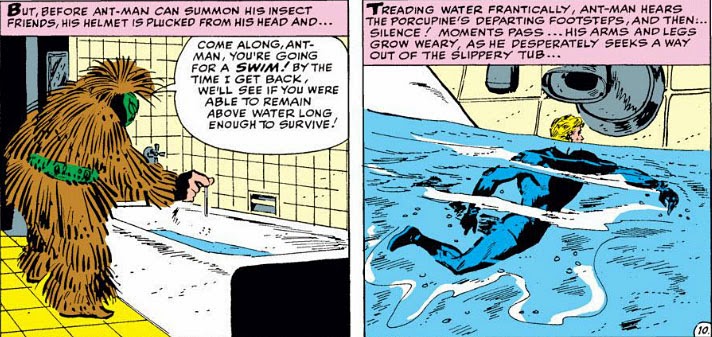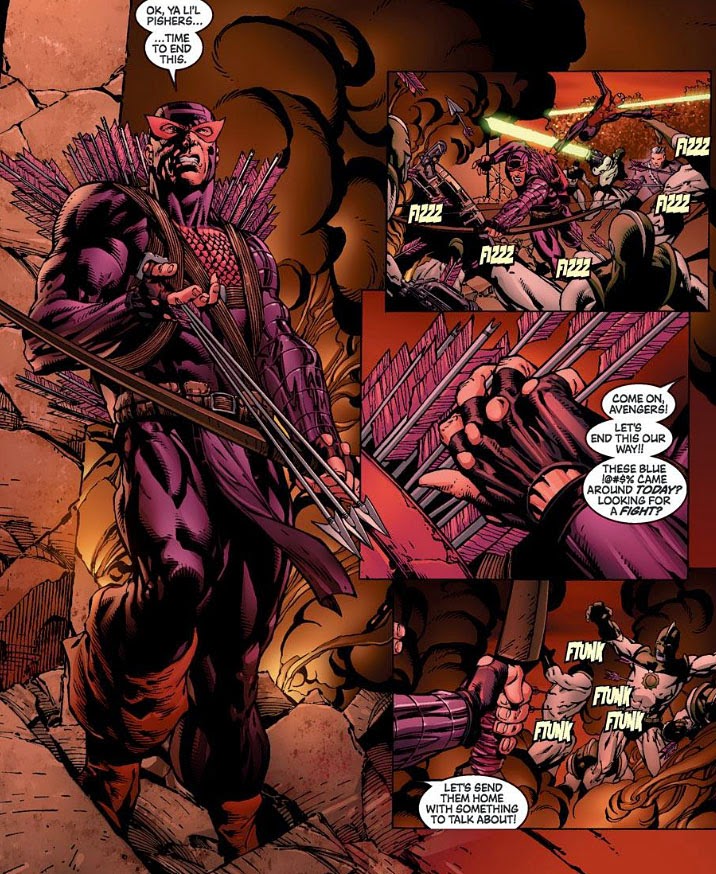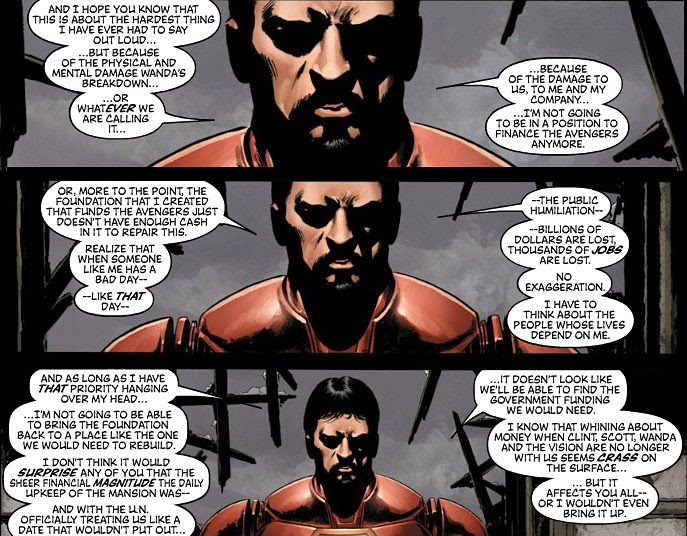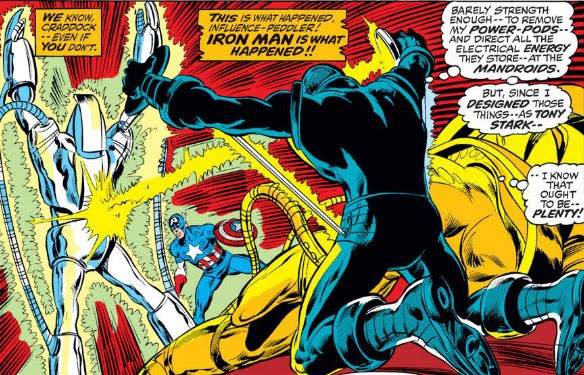![]()
Although I've never been a reader or, frankly, a fan of "the man called Nova"--the super-being created from a dying space traveller's transferral of his power to an Earth youth named Richard Rider--the
What If...? story that gives a twist to his origin story turned out to be interesting and fun reading. A four-part tale, written by Marv Wolfman while pencilled and inked by various artists (John Buscema and Joe Sinnott provide the framing art for the story, with artwork for each of the four segments provided by Walt Simonson, Carmine Infantino, Ross Andru, and George Perez, in that order), "What If... Someone Else Had Become Nova?" shows us how four different people deal with becoming a super-being--and, based on the circumstances of their lives, the outcome could turn out to be a blessing or a curse, for the recipient as well as for the human race.
It's a compelling formula for a story, the taking of a different path--one which might work equally well for just about any existing Marvel character's origin which could be deviated from (and, indeed, in the
What If...? series, we've seen many such examples). The Nova tale obviously takes a somewhat different approach, sticking to a much shorter format for each segment and thus fitting in several alternate reality tales in one issue. As a result, even as arguably tiresome a character as Richard Rider/Nova becomes much more interesting as a different character with different beginnings, unencumbered by Rider's preoccupation of growing into his role as a hero; and, just to sweeten the deal, the stories of these four alternate characters begin and end in just a few pages of the same issue.
Our
What If...? guide, the Watcher, brings us first to Helen Taylor, who is consumed with vengeance against the man who killed her husband before her eyes:
Right off the bat, we're given the impression that Helen isn't going to be either sympathetic or heroic as the new Nova. And in the frame of mind she's in when the power finds her, only hatred and obsession will motivate her from that moment forward:
And so Nova begins an incessant hunt for her husband's killer--a hunt which, in the public eye, appears as a relentless vigilante campaign against the lowest criminal elements. Yet, while her drive and effectiveness quickly establish her reputation in the underworld as well as the general public, her ruthless and deadly methods are making some question whether the ends truly justify these means:
Eventually, the Fantastic Four are asked by the government to rein her in. But, once they manage to capture her, they soon come to the conclusion that there's only one way to remove her threat:
We then learn the pointlessness of Nova's fruitless hunt and her single-minded mission:
Next, we meet Jesse, a gentle man who received the Nova power but never decided to put it to any use. One of the luckiest men alive, yet one who remains hard on his luck:
Later that Christmas Eve, Jesse finally finds refuge in an orphanage. But, on a world without super-beings, his unique energy signature will prove to radiate like a beacon to those who view the Earth as little more than a planet of resources:
The Skrulls land and burst into the orphanage, where Jesse finally decides to don the Nova uniform and do his best to repel them. But, rather than endanger the children and other residents, he lets himself be taken captive and whisked away in their ship. And, hearing their plans for the Earth, he renews the fight, with devastating and self-sacrificing results:
The last two segments deal with the other side of the spectrum, bringing us into contact with Nova-powered recipients who have tangible links in one way or another with a greater array of characters more familiar to us. First, there's Peter Parker, who has his first brush with fate not with the Nova power, but with a dangling, irradiated spider:
On this Earth, though, Peter collapses after the spider's bite and is rushed to the hospital, suffering from possibly terminal radiation poisoning--and when his aunt and uncle arrive to see him, a cascade of tragedy occurs. First, there's May Parker, who suffers a heart attack after hearing of Peter's condition. And it goes downhill for the Parker family from there:
There's no consoling Peter, who seems resigned to spending his life brooding in private research work, in the belief that nothing good can come of being close to those he cares for. But a bolt from the blue will wipe his bitterness away in a stroke:
As fate would have it, though, Ben Parker is attacked in his home by (you guessed it) a burglar--though, this time, someone arrives in time to save him from death. A fate Ben's attacker, instead, will bring on himself:
Almost instantly, however, Peter's newfound optimism and joy revert to the state of mind which preoccupied him since he was in the hospital, this time due to what he believes is irrefutable proof of the detrimental effect his life has on others:
Once the burglar's body is taken away by the law, there's little doubt that no charges will be filed against Peter--but his state of mind is such that he comes to a fateful decision:
Finally, it's a truly villainous Nova we look in on, as he and his allies celebrate the eradication of the last obstacles to their plans for domination:
Nova, together with Doctor Doom, the Sphinx, and the Red Skull, have used the original Centurion's ship and its powerful computer to achieve their goals, with Nova positioning himself as their leader:
An "uneasy alliance" is putting it mildly. With all of their opposition eliminated, it doesn't take long for Doom, the Skull, and the Sphinx to attempt their own power plays within their group and consequently devour each other whole. In fact, the only thing they still have in common is that each believes that Nova should be removed first; yet, they turn out to be their own worst enemies. Doom, while attacking Nova, is slain from behind by the Red Skull--who, when failing to kill Nova, is killed by the Sphinx. So it's down to the Sphinx and Nova, a contest which is
no contest for the Sphinx:
It becomes clear that the Sphinx has played along with this group only to expeditiously eliminate any super-powered threats to himself so that he may turn his attention to plundering through the minds of all humanity, in his quest to discover the secret to freeing himself of his immortality:
We discover, however, that, due to his own rashness, the Sphinx's methodical search will not only be long and futile, but will also needlessly result in the murder of the entire human race:
As you've probably noticed, with these four stories strung together in this way, we see in them what we generally found to be the case in the
What If...? series itself--that, with rare exception, the characters meet tragic ends. At times you almost think the book's title should be changed to something like "
If Only..." and resign itself to that format, though that would be tipping its hand and letting readers pretty much know the kind of ending they're going to find waiting for them. With characters like Helen Taylor and our unnamed Nova in the villain cabal, that kind of ending makes for good reading; in fact, in Jesse's case, it lends a nobleness to his character, though I was pulling for him to survive and discover the fulfillment of sharing his power and optimism with the entire world.
In Peter's case, though, I couldn't buy either the ending or the state of mind he chose for himself, a conclusion to his story which seemed too easy on Wolfman's part. In "our" reality, Peter also felt responsible for his uncle's death, just as he did here for May's (and, inexplicably, for the burglar's)--but with his new power he went on to try and make sure that no one else would suffer for his indecision. A trash can dumping of his Nova costume, just to seemingly mimic the famous scene where Peter discarded his Spider-Man costume, felt a little too much like tragedy done for the same of tragedy. His aunt's death was due to her ongoing heart problem, and his Nova power not only enabled him to walk again but allowed him to save his uncle's life--there seems little reason for this Peter Parker to blame himself far more than his counterpart.
That quibble aside, you'll find this issue a fine effort by all the hands involved in it. And even if you were never a Nova follower, you may find yourself having a greater interest for the character, if well after the fact.






























































































































































































































































